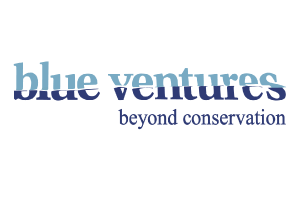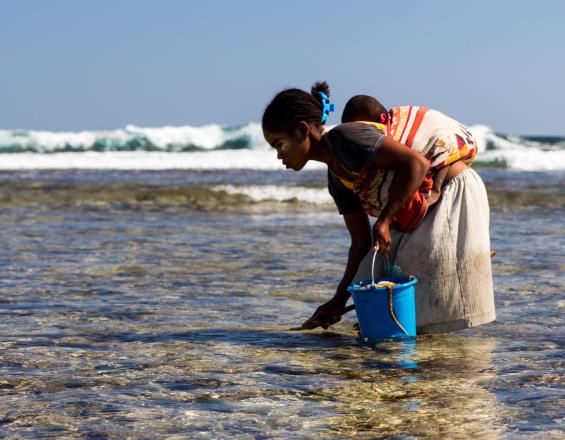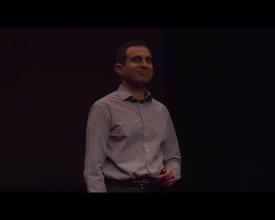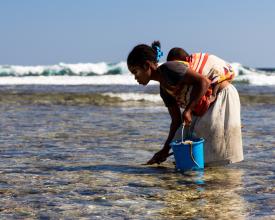
A multisectoral approach bolstering resilience for people and planet

The COVID-19 pandemic has highlighted the inter-connectedness of environmental and human health. This is acknowledged in many recovery strategies, including the WHO’s first prescription for a healthy, green recovery from the pandemic, which is to “Protect and preserve the source of human health: Nature.” This awareness underpins a growing understanding that our most pressing global challenges require multidimensional, multisectoral solutions.
Blue Ventures recognises the links between poor health, poverty, environmental degradation and vulnerability to climate change. In response to these interconnected challenges, we have developed a holistic approach to conservation, integrating community health services with local marine management and coastal livelihood initiatives. This approach creates operational efficiencies and synergies that make us highly effective at achieving health and conservation goals. It has also enabled our partner communities to better navigate the COVID-19 pandemic.
Context
Challenges addressed
- Poor community health, limiting communities’ ability to engage in conservation
- Poverty and heavy reliance upon natural resources, with a lack of alternative livelihoods
- Overfishing and the collapse of marine ecosystems
- Weak national public health systems
- Limited community ability to respond to shocks and stressors (such as pandemics or extreme weather events
Location
Process
Summary of the process
Through listening to communities, addressing community needs in a holistic way, including ensuring that they enjoy good health and have access to financial resources, communities are better able to address longer term goals such as the sustainable use of marine resources. Investing in building community capacity for marine resource management means that those most reliant on those resources are enabled to manage them, for the benefit of people and planet.
Building Blocks
Strong local presence, empowering communities and building local capacity
Our strong local presence, and emphasis on working in partnership with communities and local stakeholders to rebuild fisheries, has meant that much of the work has been able to continue in spite of travel restrictions and other disruption caused by the COVID-19 pandemic. Empowering communities to sustainably manage their own resources and health services has proven to be a more resilient approach to conservation in the context of this major shock.
Communities have the most to gain from the effective management of natural resources (and good community health services), and the pandemic has served as a powerful reminder of the value of locally led approaches to marine conservation.
Enabling factors
- Long term local presence
- Staff recruited from the local community
- A willingness to listen
Lesson learned
- Invest the time to build relationships with communities, keep putting communities first
- Focus on building local capacity for the long term, harness local wisdom, draw upon and help to build social capital
Addressing community needs
In order to enable communities to engage in the complex, long term work of the sustainable management of marine resources, their basic needs must be addressed. Working across sectors to enable communities to meet their basic needs creates an enabling environment within which they are able to work towards longer term goals.
The need for a livelihood is addressed through Blue Ventures’ work to rebuild fisheries, and through livelihood diversification initiatives where appropriate. The unmet need for health care is addressed through supporting and strengthening local health systems, and through partnerships with health care providers.
Working in a multisectoral way creates efficiencies through the sharing of resources and opportunities across programmes. It provides opportunities to broaden community engagement and build trust, and experience has shown that it enables communities to better respond to shocks and stressors.
Enabling factors
- Multidisciplinary teams
- Taking a whole system approach to problem solving and developing a theory of change
- Strong partnerships with actors from different sectors
Lesson learned
- Build a unifying vision and integrated program of work with partners, based on shared values and respect for each other’s contribution to the overall goal and with buy-in from the whole team
- Capture and share evidence of the added value of working in a multisectoral way
- Ensure effective communication with all stakeholders, anchoring messaging in the purpose of collaboration
Access to financial resources
Small scale fishing communities were heavily impacted by the COVID-19 pandemic. Reduced demand for seafood due to the disruption in distribution and decline in tourism led to reduced seafood prices, resulting in a significant drop in household income. Having access to alternative livelihoods and/or access to savings helped to mitigate this loss in income.
Alternative livelihood programmes can increase local resilience to economic shocks. Alternatives accessed during the COVID-19 crisis included seaweed and sea cucumber farming, drying or smoking fish to preserve and store it until markets recover and collectors return.
Community-led savings and loans groups have provided a critical buffer against financial difficulties as they enable people to save money and access credit in remote areas where this would otherwise not be possible. These locally led community groups pool together their savings in order to address financial hardship and provide loans to those most in need within their group.
Enabling factors
- Strong community relationships
- Short term fisheries closures, delivering rapid economic returns to communities, periodically boosting fisher income
- Private sector partnerships enabling the development of community based aquaculture
Lesson learned
- For fishing communities, focus on rebuilding fisheries as the primary livelihood
- Seek out partnerships to support livelihood diversification and the establishment of savings and loans schemes
Impacts
- The health and economic impacts of the COVID-19 pandemic were mitigated
- Improvement in the health of communities
- Greater ability to earn a livelihood and engage with non-extractive livelihood opportunities
- Greater food security
- Greater sense of empowerment
- Greater community ability to engage in natural resource management
Beneficiaries
- Local communities in the area of implementation
- Neighboring communities, and coastal communities throughout Madagascar through knowledge sharing and capacity building

